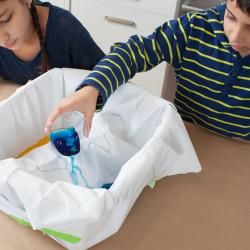Source Institutions
Source Institutions
Add to list Go to activity
Activity link broken? See if it's at the internet archive

Where rainwater goes after the rain stops? And why there are rivers and lakes in some parts of the land but not in others? In this activity, learners will make a model landscape using a plastic bin, sheet of plastic, and markers & food coloring to investigate the movement of water and find out how watersheds are formed. Step-by-step instructions are included with photos along with safety recommendations. Activity guide includes a "What's going on?" explanation and relevant connections to healthy watersheds, runoff, and the effects of pollution.
- 5 to 10 minutes
- 10 to 30 minutes
- $10 - $20 per group of students
- Ages 6 - adult
- Activity, Model
- English
Quick Guide
Materials List (per group of students)
- Plastic bin (at least 45 cm long × 30 cm wide × 10 cm deep)
- 10-15 pieces of newspaper or scratch paper
- Thin sheet of plastic, approximately 70 cm × 70 cm (tablecloth or shower curtain)
- Black, blue, and green permanent marker
- Tap water
- Spray bottle filled with water
- Two drinking cups (coffee mug or larger)
- Blue and yellow food coloring
- 30 mL (2 Tbsp) of coffee grounds
- Rags or paper towels for cleanup
- Scissors (optional)
- Liquid measuring cup (optional)
Subjects
-
Earth and Space Science
-
Earth Processes
- Weather and Climate
-
Earth Structure
- Oceans and Water
- Biosphere
-
Earth Processes
-
Engineering and Technology
-
Technology
- Manufacturing
-
Technology
-
Life Sciences
-
Ecology
- Ecosystems
- Human Impact
-
Ecology
Informal Categories
- Nature and Environment
Audience
Learning styles supported:
- Uses STEM to solve real-world problems
- Involves hands-on or lab activities
Other
This resource is part of:
Access Rights:
- Free access
By:
Source Collection
- DIY Science Apps
Rights:
- , The Regents of the University of California, 2015
Funding Source:
- National Science Foundation, DRL1114663
